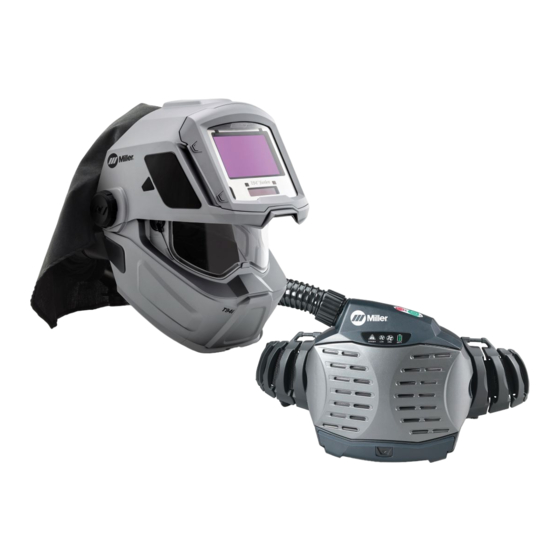Miller PAPR Manual - Página 5
Procurar online ou descarregar pdf Manual para Acessórios de soldadura Miller PAPR. Miller PAPR 40 páginas. Auto-darkening helmets

RESPIRATOR (PAPR) MISUSE can be hazardous.
Welding produces fumes and gases. Breathing these fumes and gases can be haz-
ardous to your health.
D Read and follow these instructions and the safety labels carefully. The powered air purifying
respirator (PAPR) helps protect the user from specific airborne contaminants but must be used
correctly to be fully effective. Have an industrial hygienist test the air in your facility to ensure
the PAPR provides adequate protection from contaminants in your environment. If you have
questions about the respirator, see equipment NIOSH label and consult your Safety Director
and an Industrial Hygienist.
D Follow all applicable ANSI, OSHA, CSA, and other regulatory guidelines pertaining to the use
of respirators.
D Do not use the powered air purifying respirator where there is danger of fire or explosion.
D Do not use the powered air purifying respirator in windy conditions or negative pressure inside
the hood may draw in contaminants from the outside air.
D Do not use the powered air purifying respirator without a properly installed spark guard. With-
out the spark guard, welding sparks may ignite the filter or damage the filters and allow unfil-
tered air into the helmet.
D The powered air purifying respirator does not supply oxygen. Use the respirator only in atmo-
spheres for which it is NIOSH approved. Do not use the respirator where oxygen levels are
19.5% or lower, where contaminant levels are unknown or are immediately dangerous to life or
health (IDLH), or where the contaminant levels exceed the respirator specifications.
D Do not enter a hazardous area until you are sure the respirator equipment is correctly as-
sembled, working properly, and properly worn.
D Before each use, inspect the respirator equipment for damage and verify it operates properly.
Before using the respirator, test air flow to verify it is providing an adequate volume of air.
D Do not use the powered air purifying respirator without all filter components or with the blower
turned off or hazardous levels of oxygen and carbon dioxide may accumulate in the helmet.
D Always wear the powered air purifying respirator when entering a contaminated area. Do not
remove the respirator until outside the contaminated area.
D Dangerous contaminants may not smell or be visible. Leave the area immediately if you notice
the following:
. . .
Breathing becomes difficult.
. . .
You experience dizziness, impaired vision, or eye, nose, or mouth irritation.
. . .
The powered air purifying respirator alarm sounds.
. . .
The equipment is damaged.
. . .
Air flow decreases or stops.
. . .
If you think the equipment is not supplying adequate protection.
Do not remove the equipment until you are in a safe area.
D Do not repair, modify, or disassemble the powered air purifying respirator or use with parts or
accessories not supplied by the manufacturer. Use only NIOSH approved components.
D Replace damaged or clogged filters. Do not wash or reuse filters. Do not clean filters by tapping
or with compressed air or filter elements may be damaged. Dispose of used filter elements
according to local, state, and federal requirements.
D The powered air purifying respirator must be used with the helmet, hood, and filters recom-
mended by the manufacturer to provide a NIOSH-approved respirator system. See the NIOSH
label for information on the required equipment.
D Do not use the powered air purifying respirator belt and shoulder straps as a safety harness.
D The powered air purifying respirator contains electrical parts which have not been evaluated as
an ignition source in flammable or explosive atmospheres by MSHA/NIOSH.
OM-235 936 Page 3
